The Wild Flowers of Skopelos
Blog
For those who love Skopelos and the wildflowers of Greece
The Wild Flowers of Skopelos
Blog
For those who love Skopelos and the wildflowers of Greece
Now more than 350
flowers and trees

The Wildflowers of Skopelos is for those who love the island of Skopelos and the wildflowers of Greece.
There are now over 350 flowers and trees and also information on the island, its floral landscape, geology, climate, and ecological habitats.
A Walk to Sendoukia
A place for all seasons
10 Mar 2022
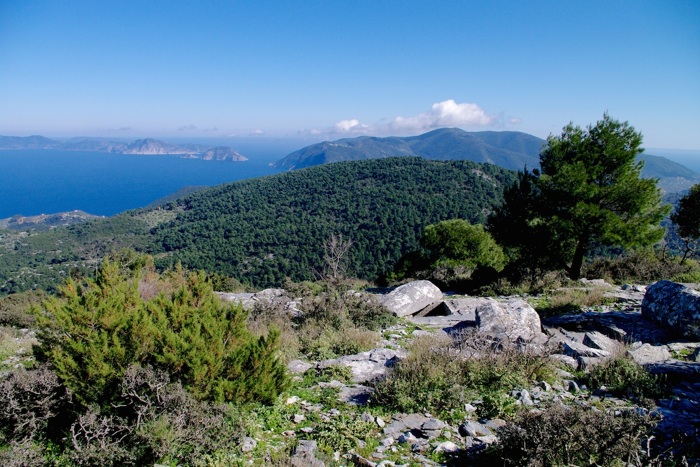
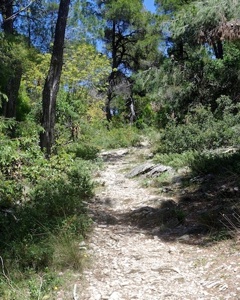
Sendoukia with its ancient graves creates a unique ecosystem. The walk starts by taking the path to the right, where the tracks to Kalogersos and the heights of Delphi divide. At first it passes through Aleppo pine forest, typical of much of the rest of the central portion of the island, with a understory of Macchia species, mainly arbutus and pistachia.
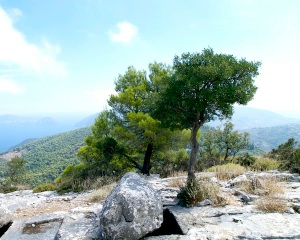
The graves are situated on a rocky outcrop of carboniferous limestone and as one approaches Sendoukia, the overlying mantle of soil thins out and the trees become smaller and sparser, but with different species making an appearance: juniper, kermes oak and cretan maple, some appear to spring from the rock itself, like the one standing sentinel over one of the graves.
When the rocky outcrop of Sendoukia is reached, the bedrock, is bare of soil and forms a limestone pavement patterned with lichens.The trees grow only from deep clefts (grykes) between the blocks of stone (clints). There are junipers, wild olive, kemes oak and aleppo pines, all stunted, contorted and deformed by the harsh dry environment where they are exposed to extreme heat in summer, cold in winter and tortuous winds.
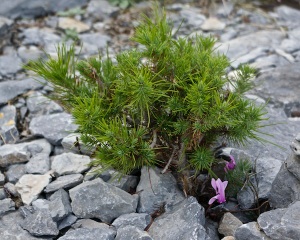
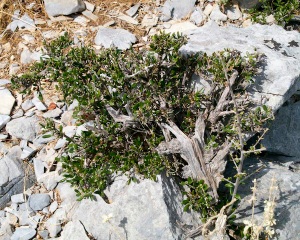
In midsummer the area lacks colourful flowers; the rocks are outlined with dried Greek horehound (Ballota acetabulosa), skeletons of verbascum and shrunken rosettes of pale stonecrop (Sedum sediforme).
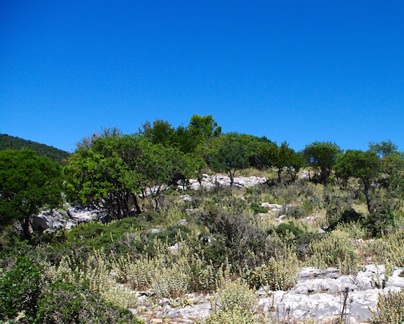
At first signs of spring the path to Sendoukia is strewn with the milky white flowers of star of Bethlehem (Ornithogallum collinum).Then in early summer the fragrant thymes come into flower, Thymus longicaulis, with its pink flower heads appear first followed later by the more robust thyme,Thymbra capitata, whose small shrubs, with gnarled woody stems are densely covered with purple flowers, attracting many bees and butterflies. On the headland in June frothy heads of pale stonecrop (Sedum sediforme) are flourishing, their succulent leaves helping them survive the harsh conditions.
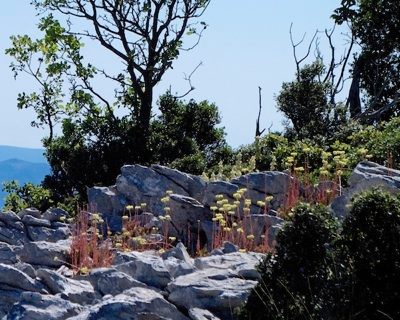
Autumn brings the colours characteristic of the season to the deciduous trees and shrubs,: gold, orange and red. Purple heather blossoms on the edges of the pathway and the delicate crocuses (Crocus cancellatus) with their pale tepals and bright orange stigmas, are scattered among the rocks. The greek cyclamen are in flower throughout the island but here their beautiful pale pink to magenta flowers and dark green leaves marked with white are enhanced by the contrasting hard rocky surrounding.
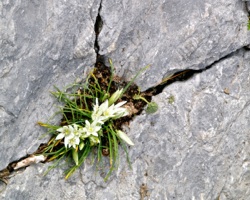
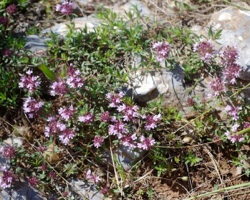
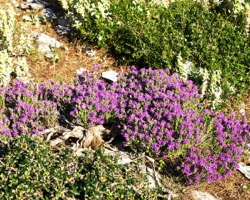
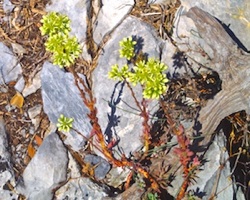
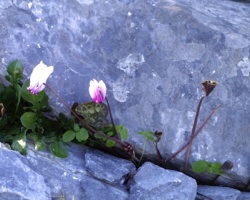
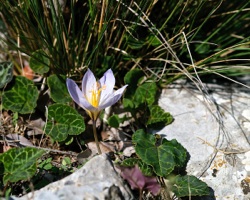
Top: Ornthogallum collinum, Thymus longicaulis, Thymbra Capitatum.
Bottom: Sedum sediforme, Cyclamen graecum, Crocus cancellatus.
In summer there is a lack of wildflowers either on the path or the exposed plateau The walk, however is not in vain, as you are still rewarded by the views of the dense forest below, which gives the Skopelos the epithet Green on Blue Island and the magnificent views of the Northern Sporades Archipelago beyond. This is a wonderful place from which to observe the evolving colours of dawn.
For those wishing to do a longer guided hike to Sendoukia contact Heather Parsons.
See: https://skopelos-walks.com/the-pera-karia-sendoukia-adventure-trail/
Euphorbias or spurges
The most Greek of wild plants
6 Jan 2022
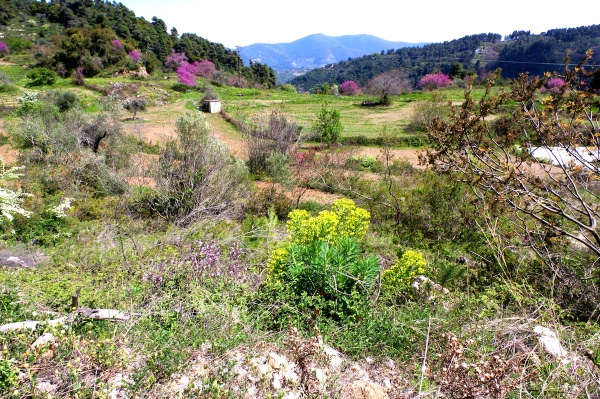
The Euphorbias or spurges seem to be the most Greek of wild plants. The large E. characias make a dramatic statement, flamboyant in spring and standing out against the otherwise barren hillsides in summer ; their unusual musky aroma is reminiscent of the hot summer Greek days .The genus, Euphorbiaceae, comprises a wide variety of plant forms, which includes Christmas poinsettias and plants from Southern Africa which resemble cacti as well as herbaceous plants and trees.The Mediterranean euphorbias are mainly herbaceous forms but there is also the tree form of E. dendroides and prickly bushes of Greek spiny spurge, E. acanthothalmnos.
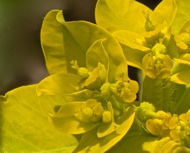
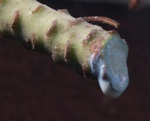
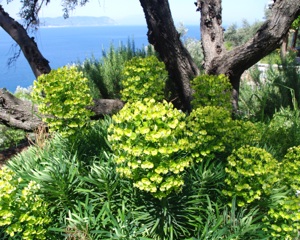
Over recent decades the mediterranean euphorbias are have become popular as garden plants, their statuesque structure creating architectural interest. They bloom after the more familiar flowers have lost their petals and died back, they produce intriguing aromas and persist with interesting foliage throughout winter.
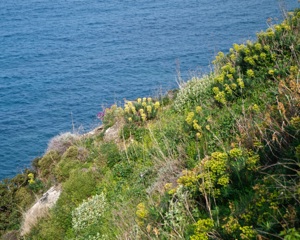
After travelling from Western Europe when you smell the unique aroma of Euphorbia characias and see the stately plants with their flamboyant flower heads, you can be sure you have arrived in Skopelos.





For more euphorbias see Kjel’s website
Goats in the forest
5 Nov 2021
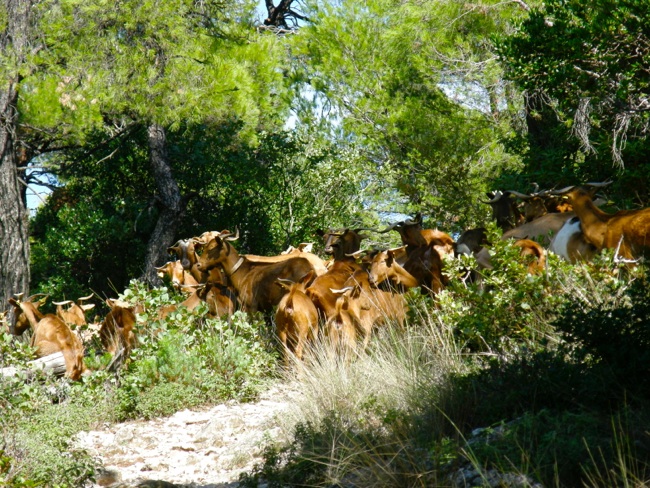
Goats have had a presence in the Northern Sporades since prehistoric times, with faunal remains found in the Cyclops Cave on Gioura dating back to the mesolithic era (8,600 - 7,700 B.C.).The presence and morphology of these bones suggests that the early human visitors to these islands were involved in the earliest experiments in the domestication of goats. A herd of ancient breed of free roaming goats. still exists on Gioura today.
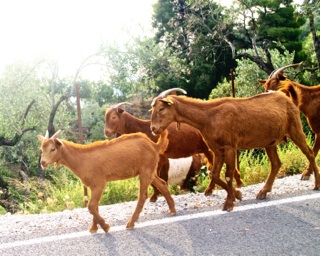
The raising of goats has been a part of the pastoral life throughout Greece for millennia and goat farming continues to be important to the traditional life on Skopelos; they can often be seen being herded along the roads, feeding in open land, grazing in the forest or even clambering on the roofs in the town.
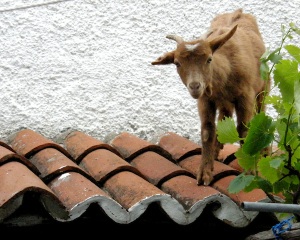
Skopelos goats are prized for their milk, which is used to make excellent yoghurt and cheeses, as well as for their meat. Goat spit-roasted over charcoal is the meat of choice at any family celebration on Skopelos and especially at Easter.
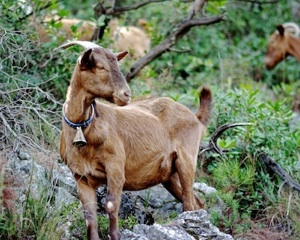
In the past goats were given bad press by many botanists as destroyers of valuable and rare plants and of causing damage to the ecological environment, particularly on islands.Between WW1 & WW2 ( 1936-1941) reduction of goat numbers in Greece was considered to be a political imperative. Metaxas declared that “Goats and forests cannot coexist”. The corollary however is true - goats, unless in excessive numbers can contribute to forest management.
It is recognised that over-grazing has contributed to desertification on Samothraki, where there are over 45,000 goats. Part of the island has green valleys and verdant streams with rare wild flowers but the rest is bare and dry. A similar situation exists on Skyros but a community initiative has been established, to control their numbers and areas where they are allowed to graze.
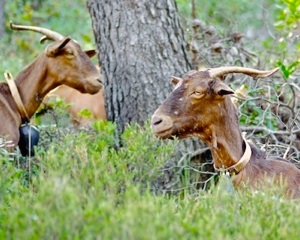
Properly managed, they maintain forest clearings, maintaining fire breaks; they graze on the understory, reducing the fuel mass available for combustion and increasing the distance between the shrubs and bushes and the forest crown, creating vertical fire breaks.
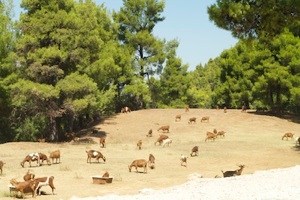
Goats are reputed to eat everything, but goats which are allowed to range in the forest in areas chosen by the goatherd. where they are allowed to choose their own diet.
A number of studies over recent decades have shown that grazing goats can “induce changes in plant species diversity without lowering species richness and reduce the risk of fire.”
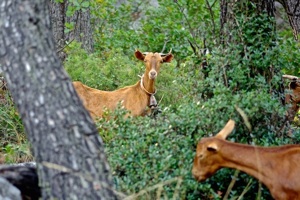
On Skopelos the goat support the balanced ecosystem and have helped create the mosaic of habitats characteristic of the Mediterranean biosphere and they continue to contribute to the rich cultural life of the island.
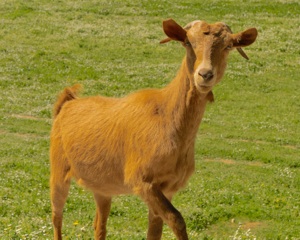
Goats are not the destroyers of the environment - humans are !
See also “Hero” on the Skopelos News.





Rubiaceae
The bedstraw family
3 Aug 2021
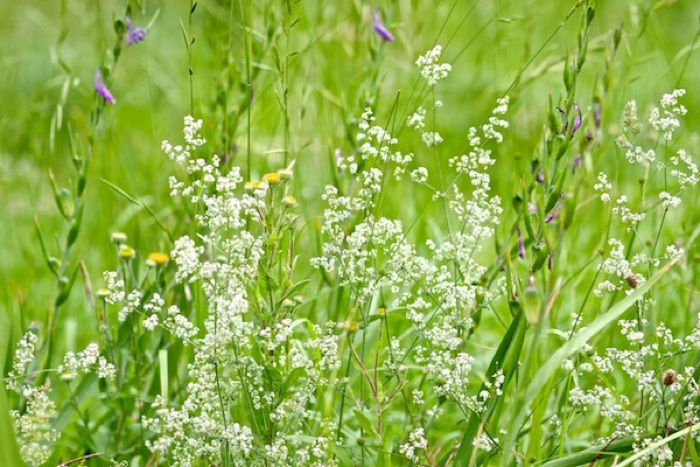
The Rubiaceae family is also known as the bedstraw, madder or coffee family. It is an important worldwide plant family, including the coffee plant, (Coffea arabica) and chicona (Chicona officinalis) the source of quinine used in medicine to treat malaria and to flavour tonic water, as well as many weeds and a number of plants used to produce dyes, all referred to in English as madder.
The family is represented on Skopelos by a number of plants of varying morphology; from the long, straggly, troublesome weed, Galium aparine, to the inconspicuous little plant, bristly crosswort (Valantia hispida), which grows at the base of calciferous rocks. There is also the fragile Sherardia arvensis, a plant of Mediterranean grassland with its flowers of palest pink and stinking madder (Plocama calabrica), with its pretty deep pink flowers but foul smell, whose roots have traditionally been used to produce a red dye and wild madder (Rubia peregrina), whose roots are the source of an orange dye.
On Skopelos Galium heldreichii, is botanically important, as the first specimen of the species ever identified was found on the island by the Greek plant collector Christos Leonis* and described by the famous botanist Halacsy*.
*For more on the botanists see last month’s blog below.
Four new flower pages have been added to the website,
all are Rubiaceae.




Botanical explorations of the Northern Sporades
“In every culture and throughout time, flowers have been central to the human experience.”
Vanessa Diffenbaug.
1 Jul 2021
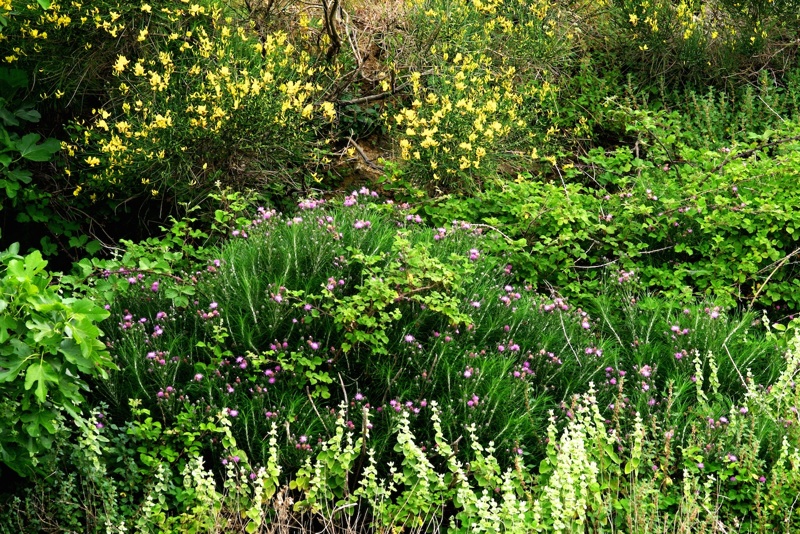
Rechinger commented on the beautiful Ptolostemon chamaepeuce opposite Skopelos harbour
With its high mountains and scattered islands, Greece has long been known as a country with a rich and varied flora which has attracted the attention of botanists since ancient times. With the recognition of island complexes as biodiversity hotspots and natural laboratories with valuable but fragile ecosystems, it is not surprising that these scattered islands have attracted the attention of a number of famous botanists who have visited the Northern Sporades, collecting specimens and adding to the understanding of the natural environment, plant evolution, the influence of man and environmental change.
In ancient times until the modern age, plants provided food, building materials, fibres for clothing and medicines. This made the collection and the accurate identification of plants was even more important than it is today, but the study of plants and application of modern methods to their assessment continues to be an important activity and will help to understand and preserve the natural environment.
One of the first accurate catalogue of plants and their medicinal uses was De materia medica was written by Dioscorides during the 1st century A.D. but is was the 18th and 19th Centuries which were considered the Golden Age of plant collecting in Greece. Those expedition leaders who visited the Sporades include, Joseph Pitton Tournefort, John Sibthorpe, Dumont D’Urville and later Heldreich, Halacsy and in the 20th Century, Rechinger, Dimitrios Phitos. These names will be recognised by professional and amateur botanists as many plants have been named after them or by them.
A new page has been created on Botanical Explorations of the Sporades.
......for more click Botanists






white pink purple/mauve red blue green/brown yellow/orange orchids trees
white pink purple/mauve red blue green/brown yellow/orange orchids trees